Search results
3 results found.
3 results found.
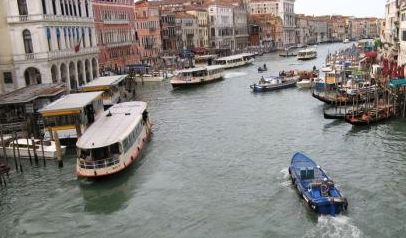
Every time I tell an arriving friend that a single ride on the vaporetto here is going to cost 7 euros ($9.26), I stifle a shriek. Though if I were to let myself shriek, it might cover the sound of my friend’s shriek. Or gasp. Or disbelieving laugh.
Why vocalize at all? Because the city covers roughly a mere four square miles (ten square kilometers), and while ten dollars may not seem unreasonable if you want to travel the length of the Grand Canal on the faithful #1 from Piazzale Roma on to the end of the line at the Lido (apart from the crushing crowds, it could qualify as one of the cheaper scenic boat tours in the world, I guess), it seems a demented price if you only need to go four or five stops.
For the record, I have done some calculations, and the average distance between stops is 1,141 feet (348 meters). The time involved in each leg is usually around five minutes. If you only need to go a few stops, the price comes to a lot per minute. It’s true that you can often reach your destination faster on foot, but not if you’re lost, and dragging suitcases the size and weight of the foundation stones of the Great Ziggurat of Babylon.
Note to readers: There are unlimited-ride tickets available for specified lengths of time for much less per ride, but that’s beside my point.
Returning to my point: The cost of public transportation in the most-beautiful-city-in-the-world. It wasn’t always thus, back when there were more residents than tourists. But over the years, although the number of residents has fallen, the number of tourists has risen which, according to my primitive notion of economics, ought to mean that the price of a ticket should shrink. Silly me.
“We have no money” remains the one-size-fits-all justification given by the ACTV, the transport company, for anything it does or doesn’t do; it has adopted this motto from the city government as a whole (note: the city is a part shareholder in the ACTV).
But why do we have no money? One reason could be the effect of the thieving ticket-sellers; there was a lively period in which sticky-fingered employees were turning up all over, discovered selling tickets worth a fraction of the price they charged for them and pocketing the difference, or counterfeiting tickets (back in the paper-ticket days), or other simple little dodges that worked surprisingly well for a surprisingly long time, taking home what amounted to multiple thousands of euros.
Another reason for the belt-tightening which was given in the somewhat distant past (and my favorite): “Do you have any idea what a can of paint costs?” Visions pass through my mind of surging oceans of paint upon which little bits of tickets are floating.
But a new glimpse of why they have no money may be discerned in a recent series of detailed articles in the Gazzettino, and the reason is the simplest of all: The ACTV has no money because they’ve spent way too much of it, particularly on failed conveyances.

There was the revolutionary vaporetto dubbed the “Mangia-onde” (or Waves-Eater, a nice, Norse-saga sort of nickname) which was going to banish waves and make their destructive effects a fading memory. It was built by the M Ship Co, of San Diego, California. One craft was bought and came to Venice in 1999 to great fanfare and trailing clouds of glory and the promise of the salvation of the city from motondoso.
But it was too good to be true. Not because it created waves, but because it created problems. For example, it wasn’t adapted to lagoon conditions (I take that to mean it was unstable); it didn’t pass under the bridges, such as the Ponte delle Guglie, and also the hull wasn’t fireproof.
The Mangia-onde was taken to a shipyard in Castello where it sat, abandoned, for 13 years. A few weeks ago this once-proud herald of the future, which had cost 900,000,000 lire (464,811 euros, or $651,061) was sold to a private buyer for 20,000 euros ($26,465). Without the motor. Nobody seems to know what happened to it.
The current director of the ACTV, Maurizio Castagna, was also director in the late Nineties. He explained that the boat was put aside because “It didn’t meet the standards of the Italian Naval Registry, and also because of a series of onerous (that means “expensive”) maintenance interventions and adaptations of the boat to the lagoon area.” One certainly couldn’t be expected to know what the legal nautical standards were (I’m thinking of the fireproofing), or what characteristics a boat has to have in order to putter around the lagoon, especially if you’re in the aquatic transportation business. So that was that.
Bonus digression: The saga of the bargain ferryboat a few years back. Just more of the same old from the ACTV.
There is now the “Sandra Z.” to consider, a motonave which the Gazzettino has dubbed the “latest ‘hole in the water’ of the ACTV.” She too was built and unveiled to great pomp in 1999, and since 2006 she too has been nestling in mothballs.
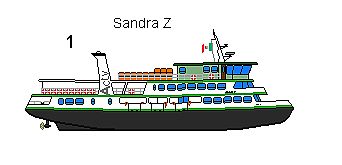
She was built (in Messina, curiously, not at a Venetian shipyard, but let’s not get distracted) to carry 1,200 passengers — the perfect vehicle for the pilgrims traveling around Italy in the Jubilee year of 2000 (who never materialized, in Venice, anyway). But even if they had shown up, they’d have had to start a new round of prayers and supplications after climbing aboard.
The system of propulsion created serious problems of maneuverability. The “Schottel” (name of its German company) enables the propellers to work at 360 degrees, which — says the Gazzettino — transformed the ship into a sort of spinning top that couldn’t be managed by its captains, not to mention the unpleasant effect on the passengers.
I am not qualified to make any judgment on the qualities of this propulsion system; I have no doubt that it is excellent in many situations. Just not on a motonave. Which couldn’t have been tested, it seems, before it was too late.
Four months after its launch, it ran into the wall at the cemetery island of San Michele (four injured); not long after, it ran into the dock at Punta Sabbioni. The electronic system went crackerdogs. Finally, in July, 2002, the “Sandra Z.,” pulling away from the Ponte della Paglia by the Doge’s Palace, caused two gondolas to run into each other and their passengers ended up in the drink.
She kept on randomly running into docks until 2006, when the ACTV tied her up and turned her into a floating storehouse.
Cost: 7 miliards of the old lire (4,000,000 euro, or $5,293,000).
“No ghe xe schei.” We have no money. I begin to see why. And I begin to see why vaporetto tickets have to paid for with small gold ingots.
“No ghe xe schei” (No ghe zeh skay). It means “There is no money,” in Venetian, and it’s a phrase one hears all too often.
If Venice were to have a soundtrack, it wouldn’t be the shimmering arpeggios of Vivaldi or Marcello, it would be this monotonous lament. The statement obviously refers to the state of the municipal coffers, but it’s an extremely versatile and handy tool. It can be used either as a weapon of attack or defense, and is also useful as an accusation. It’s as much a political as a financial remark, because it explains, excuses, and removes from discussion any problem, decision, action or inaction. “No ghe xe schei” will be the reason why something was done, or why it was not done, or how it was done, or by whom, or when. Whatever happens, it will be because there are no schei.
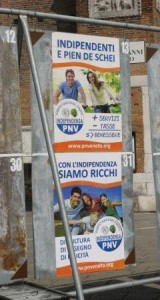
Schei is an old Venetian word from the period between 1797 and 1866, when the Austro-Hungarian Empire ruled the once-independent Venetian Republic. There was an Austrian coinage called “Scheidemunzen” (a generic term indicating that the coin was legally worth more than the metal it was made of), clearly a word that was born looking for a nickname. So the Venetians chopped off the first bit and pronounced it their own way. One scheo (SKAY-o) was one cent, that is, one one-hundredth of a Scheidemunze.
You will also still hear people use the term “franchi” to mean money. (If you were to earn some extra money, you’d tell your friends you’d “ciapa’ un franco,” grabbed some money, in the casual way we would refer to doing something on “my dime,” even if actually cost $40,000.)
The franchi don’t refer, as I once assumed, to francs circulated during the brief period when the French were the rulers here, but rather to the coinage of their successors, the Austrians. In that period there was another Austrian coin in circulation which carried the Latin name of the Emperor Franz Josef, i.e. Franciscus Iosephus. With the passion for diminutives that is one of Venetians’ more endearing traits, the money became “Franks.” So spending “franchi” would be like spending a batch of Abes or Georges today for the newspaper or a pack of gum.
While I’m off the track here, you also occasionally hear an older person refer to spending lombardi.
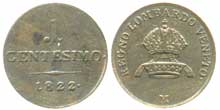
That goes back to the period of the Kingdom of Lombardy-Venetia (1815-1866), a sort of subset of the Austrian dominions about which I will tell you nothing more because life is short, but I will mention that Lino told me he has, somewhere in his impedimenta, at least one genuine lombardo. Very cool.
Venetians buy and sell in euros now, a word which is hopeless for fantasy, but it’s used here only in specific situations, such as paying the gas bill or pricing products. Peaches would cost four euros (not schei) a kilo, but the shopper would put them back because they cost “massa schei.” Too much money. But back to the budget.
How much money does Venice need to live on? And why does it keep coming up short? (And why do the lights blaze on all night on every floor of the Palazzo Balbi, in the offices of the Veneto Region??) The numbers, as reported in the press, don’t seem to match up, and studying the documents on the city’s website gave me the staggers, so I can only sketch some broad outlines.
As with any entity, the city has Income and Expenses. You need to increase (A) or decrease (B), or both, to keep going. Even I know that. And there has been a terrifying drop in (A) recently, the fiscal equivalent of the effect suffered by non-seat-belted passengers on a plane which suddenly hits one of those invisible air pockets. Furthermore, the world economic implosion has meant fewer tourists, and those who do come are spending much less.
Conversely, the increase in (B) has been relentless.
So while the larger world worries about water rising in Venice, the mayor is fixated on the ebb and flow of funds. That sound you hear is the city government squeezing 7 million euros out of this year’s budget. There’s plenty of pain to go around.
Income, some major sources of:
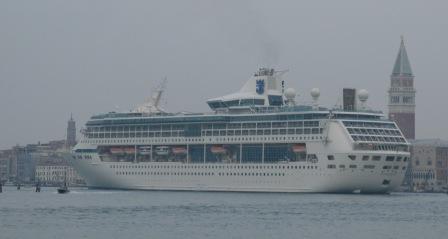
Expenses:
These are all the unromantic elements of keeping a city alive, if not well, and the budget has to cover not only the historic center of Venice, but its municipal partner, Mestre, which has its own particular problems. The struggle to resolve the very different demands of the two entities — dredge a canal or build a parking lot? — is never going to let up. But whereas people come to the historic Venice and spend money (and even respond to appeals for donations for same), it’s unlikely that the same amount of money would be forthcoming from appeals to help Mestre avoid becoming a souvenir. So there is tension. Unfortunately for historic Venice, Mestre has twice as many voters.
To sum up: The city budget currently shows 546 million euros in income, and the same amount in expenses. 467 million of those expenses are for operating costs: 134 million for personnel, and 79 million for the various departments. Welfare (a general term for various social costs) is 44 million. The police get all of 2 million. I won’t go on. Not much left over, as you can see, for the restoration of monuments and other more visible concerns of the most beautiful city in the world.
Mayor Massimo Cacciari could see trouble coming a year ago (even before the roof caved in on the economy of the Milky Way galaxy):
“TO SAVE VENICE REQUIRES 70 MILLION EUROS,” the Gazzettino headline read, beginning its report on the mayor’s unproductive trip to Rome, where he discovered that the Special Law had allocated Venice a mere 5 million for 2009. This is depressing, not only in itself, but because in a situation this dire, the need for money will tempt the city to give all sorts of waivers and exceptions and permissions to do things which are prohibited by various laws. The wild call of the schei, especially when it’s looking for a mate, is more unnerving than the cry of the migrating sandhill cranes at dawn.
“I explained to the Ministers that Venice needs annual refinancing of at least 60 million euros on the basis of the Special Law,” Mayor Massimo Cacciari said at the subsequent press conference. “Otherwise it will be difficult to guarantee — on the contrary, they could be blocked — projects tied to the maintenance of the city, of the dredging of the canals, to the restoration of the private buildings of the patrimony, to interventions for the socio-economic revitalization of the city, to the restructing of the government buildings.”
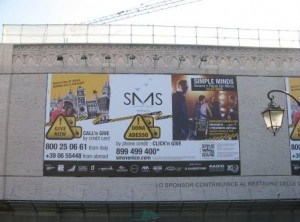
Anyone who has seen the swarms of summer tourists naturally assumes that they are all thickly padded with money, but this is not the case. On the contrary; tourism imposes more demands on maintenance (money out) than it gains from its wildly assorted visitors, most of whom — the merchants confirm — carry very little spare change these days.
Over time, the city has hazarded various proposals to increase income (and limit the number of tourists at a time, thereby controlling the maintenance problem, at least somewhat). One idea was to charge one euro from each tourist who stayed overnight (most tourism is of the “bite and run” sort, as they put it). This raised shrieks from the hoteliers, who saw it as punitive to the very people who were already actually spending money in the city. Another idea that keeps coming up is to sell an admission ticket to the city, but apart from conflict over its philosophical justification, no one has yet come up with a way to actually make it work.
So “Let’s find a sponsor” has probably surpassed “Let’s have a drink” in frequency, if not in popularity. Last year the mayor was wooing the German government for money; the movie stars who attended the Venice Film Festival were snagged as spokespeople more or less soliciting contributions; Elton John donated a bit of his music as a cell phone ringtone, the proceeds of which would go to the city.
Certainly something is better than nothing, but many of these maneuvers do have a sort of tin-cup aspect to them.
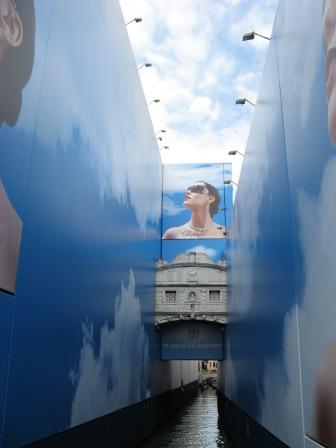
Then there are billboards, another form of sponsorship. The most overwhelming at the moment are in the Piazza San Marco area, covering the facades of the Marciana Library, part of the Doge’s Palace, the Bridge of Sighs, and the New Prisons. The aesthetic impact of these monstrous advertisements blatantly contradicts the notion that the sponsor is paying because he/she/it is sensitive to beauty and historic value. The cost of restoration has increased, and the funds have shrunk, to the point where these swathes of space are now regarded as the perfect commercial space for rent. Not a revolutionary idea in itself, but pretty subversive in a town which is also a UNESCO World Heritage Site.
There is one more aspect of the budget situation here that requires mentioning, and that is the Parris-Island-obstacle-course which an entrepreneur with a good idea has to attempt to run, from bureaucracy to high taxes to entropy, all exacerbated by the normal political parry and thrust which require time and attention too.
One such entrepreneur is yacht broker Stefano Tositti, director of BWA Yachting, and he maintains that there is much more to be earned from the luxury-yacht business than has yet been asked. “Luxury yachts is a sector that brings Venice about 10 million euros,” he told the Gazzettino; “it’s a lot of money when you consider that the work focuses on only 15 moorings used mainly in the summer. It’s not enough. There needs to be a marina adapted to the needs of people who come to Venice; here we’re not able to furnish certain services which our clients normally expect.”
In 2008, 173 of these peerless vessels adorned the embankments at the Punta della Dogana, the Riva dei Sette Martiri, and the Riva San Biagio. Some of these berths can cost 10,000 euros a day, presumably for mega-yachts such as Paul Allen’s “Octopus”
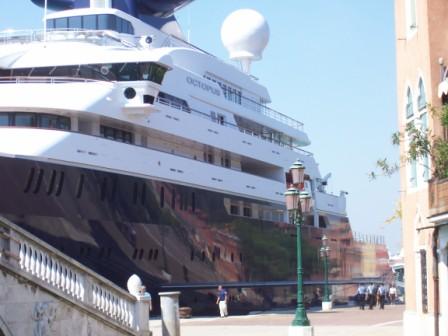
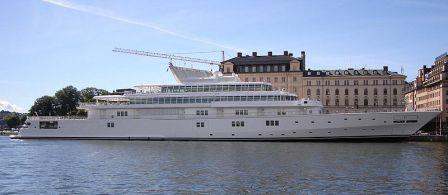
Larry Ellison’s “Rising Sun,” and Barry Diller’s “Eos,” the world’s largest sailing yacht, all of which put in to Venice from time to time. In the case of “Rising Sun,” it’s not easy to find berths it will fit into.
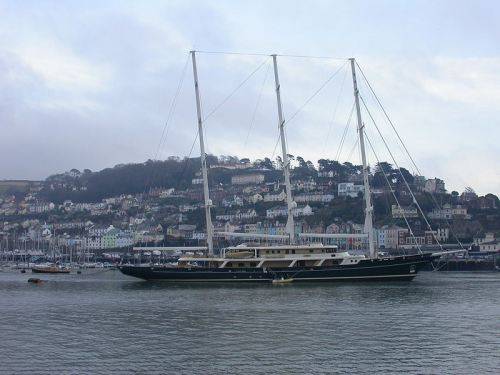
Tositti says that there are investors ready to support a marina project, and that an investment of 250 million dollars could bring earnings of 30 per cent within five years. He claims that the city could earn another 10 million euros if there were a structure for off-season storage. “The problem here is unfortunately bureaucracy,” he told the Gazzettino. “It seems as if the city doesn’t want to pay any attention to this niche market. In fact, very few berths are dedicated to this type of boat — there are very few services for yachts in general, and marinas are completely lacking in the historic center. ”
Happily, on July 2 it was reported that Moody’s had reviewed Venice’s books and awarded the city a rating of AA2, which is just below AAA and AA1. It is heartening to see that the city’s finances still pass muster. But with an eye on the drop in income from the Casino, Moody’s has also given Venice a friendly heads-up.
It appears that, at least for the near future, the margin between money made and spent in Venice will continue to be so narrow that you couldn’t even slip the average “suspension of service” notice through it. Yet still, schemes are proposed from time to time, such as the idea (since abandoned, or at least not mentioned) of installing turnstiles on all the vaporetto docks, which the city inexplicably is able to afford. This kind of maneuver only deepens the chasm between fiction and fact in this fairytale city. Yesterday the city couldn’t afford to pay more ambulance drivers, yet somehow money has materialized to install turnstiles?
It doesn’t do to dwell on these things. They only make you tired and unhappy.
###articles###

The festival day actually started the evening before, with a huge storm. (Everyone agreed, obviously, that it was better to have had it Friday night than Saturday night.) It was inevitable; we’d spent the whole week under a hot, wet woollen blanket of weather, one of those classic mid-summer heat waves that makes you hold very still and concentrate on breathing.
At around 7 — actually, earlier — a large swath of gray-black clouds began to draw itself across the sky and the breeze picked up, but we knew the storm would (couldn’t, in fact) hit until the tide turned. So we were inside, around 8:00, when the first raindrops began. Big, heavy, aggressive raindrops, smashing into the pavement one by one. Then the rain really hit. And then it turned to hail. I love the hail, it hits the canal so hard the water looks like it’s boiling. The bits of ice blew and cracked and bounced against the Venetian blinds. And the air turned cool and we could breathe again.
Lino said, “Anybody who’s out on the water in a boat right now is a coglion (male anatomical part which is commonly referred to when needing to describe a person who is a dangerous mixture of stupidity and incompetence at a level which can create inconvenience or even danger to those around him.) This storm had been threatening since 4:00 and Lino has very little patience with people who can’t take care of themselves on the water due to ignorance of what, to him, are the most elementary elements of survival. Kind of like somebody who might sit down to read “War and Peace” who wasn’t too steady with the alphabet.
Saturday morning, the Big Day, 8:30 AM: I went to the cut-rate supermarket behind our place to get some last-minute supplies. I wasn’t the only person who had thought of getting a head start on the day; there were at least five people in line ahead of me.
As it happened, the late- middle-aged man in front and the attractive middle-aged woman behind me knew each other, so they were schmoozing over and around me, in a friendly sort of way.
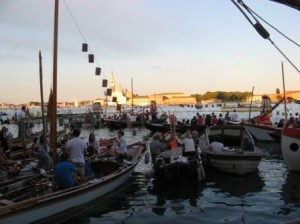 Man: “Remember when we used to decorate the boat with the frasche (small leafy tree branches), and the paper lanterns with candles in the them. That was really beautiful.” (The yet older man ahead of him chimed in, “Really beautiful.”)
Man: “Remember when we used to decorate the boat with the frasche (small leafy tree branches), and the paper lanterns with candles in the them. That was really beautiful.” (The yet older man ahead of him chimed in, “Really beautiful.”)
Man: “One year when we were boys we went and rented a boat to go out to watch the fireworks.” That was still the era when the late, lamented affittabattelli were in business. “There were about five or six of us. And we had bought fireworks, too, which we stashed under the prow of the boat.”
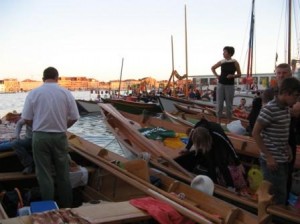
The boat was something like a sampierota, whose prow is covered; it makes a very useful storage place, which is precisely why it’s made that way. I guess you have to be a 12- or 13-year-old boy to understand the point of bringing fireworks to a fireworks display.
“Then we saw a man on the fondamenta in a tuxedo. He asked, ‘Hey, I’m late to get to the galleggiante — can you ferry me over?” “We said, Sure. So he got on and sat down on the prow.”
(“The galleggiante” literally means “floating thing,” and specifically referred to a large heavy platform which years ago on the night of the Redentor moved slowly around the Bacino of San Marco, festooned with lights, carrying a band playing music. They have attempted a version of it the past two years, but I think it may have lost its true beauty when everybody became capable of bringing their own music aboard their boats. Or maybe it cost too much. Remember: No ghe xe schei.)
The story continues: So the boys were rowing across from here to there and somehow all the fireworks under the prow ignited. Which means “exploded.” I never heard what set them off, but once they start, that’s it.
“The man in the tuxedo had to jump in the water and swim,” our guy continued. “In fact, we all did. It was like a powder magazine going up. The boat pretty much caught on fire and just kept burning.
“It took us two years to pay off that boat,” he concluded. “We’d go by and pay the boat-renter 5 franchi, 10 franchi, whatever we had.”
What did your parents say? I had to ask.
“Oh we never told our parents,” he answered.
This was a fantastic start to my day.
The rest of the festa went pretty much as anticipated:
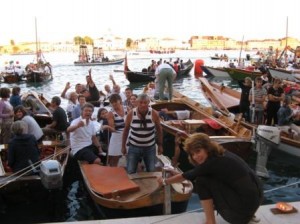
Beauty. Merriment. Friends — some 14 of them, assorted. Food: the strictly traditional bigoli in salsa (whole-wheat spaghetti with anchovy sauce), sarde in saor (fried sardines in sweet-sour onion sauce), and bovoleti (tiny snails in oil and garlic). Some non-traditional meatballs, too. Lots of wine. And shortly before the fireworks began, we slaughtered the watermelon — there must be watermelon, it’s non-negotiable. The next morning you can still see shards of watermelon rind floating around.
The fireworks started 15 minutes late. This put a serious brake on the merriment, which is emotionally calibrated to the start of the uproar. At least I personally am so calibrated. Fifteen minutes is too long to keep your anticipation at its peak, especially if it’s practically midnight.

I will say that while there are no bad fireworks, there are those which are great and those which aren’t. These were not great. The Gazzettino reported the next day that they were “probably the best there had ever been,” which is preposterous. Last year they were the best that there had ever been, and ever will be. This year we had lag, and long pauses, and repetitions. I can say they were louder than usual, but I don’t give points for loud. The hailstorm the night before was much more exciting.
We rowed the caorlina back across the dark lagoon, as other homeward-bound boats chugged past us. Put the boat away, policed up the campground, so to speak (many bottles and other detritus to dispose of), and then home. Which on the Lido means waiting for the night bus, which is not frequent, and then the night vaporetto, ditto.
It was a fine Redentor, but I wouldn’t put it up in my top five, if anyone is keeping score. Apart from last year, the only other truly unforgettable one was the year we heard that a friend of ours had just “come off,” as climbers put it, a mountain in the Dolomites the afternoon of the Redentore. I’ll never forget sitting in our little mascareta that night, not eating, the fireworks all blurry, throat hurting. Poor Giorgio. I think of him every year.
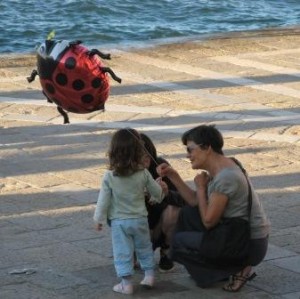
But the next day happiness reigns once again, as the sun pours itself all over the city and down on the three afternoon regatas, and the stands in front of the church selling balloons and candies in alarming colors, and then the solemn mass and blessing of the city by the patriarch.
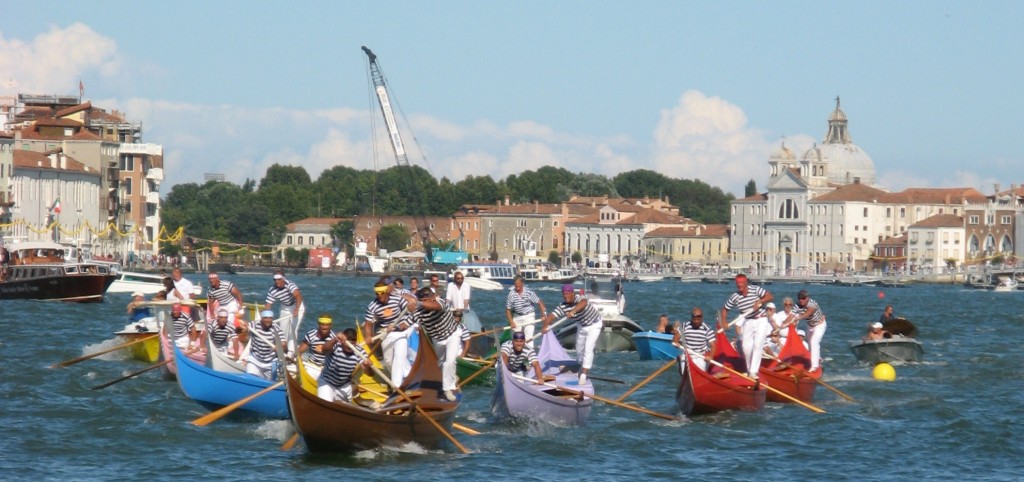 Of the three races, the One that Counts is the third: gondolas raced by pairs of men. Back in the barely rememberable past the racers were all men who were not exactly athletes; in fact, the broad sash each rower wears (matching the color of his boat) originally functioned as a sort of truss, I think you’d have to say. Nowadays the competitors train in a seriously focused way, and so instead of having a race in which the battle lasts for the first five minutes, and then everyone just stays where he is till the finish, as it once was, now you have battles to the death all the way through. Especially between two specific pairs of men whose rivalry has reached a level not far from blood feud. I refer here to the brown gondola (Ivo Redolfi Tezzat and Giampaolo D’Este) and the yellow (Rudi and Igor Vignotto).
Of the three races, the One that Counts is the third: gondolas raced by pairs of men. Back in the barely rememberable past the racers were all men who were not exactly athletes; in fact, the broad sash each rower wears (matching the color of his boat) originally functioned as a sort of truss, I think you’d have to say. Nowadays the competitors train in a seriously focused way, and so instead of having a race in which the battle lasts for the first five minutes, and then everyone just stays where he is till the finish, as it once was, now you have battles to the death all the way through. Especially between two specific pairs of men whose rivalry has reached a level not far from blood feud. I refer here to the brown gondola (Ivo Redolfi Tezzat and Giampaolo D’Este) and the yellow (Rudi and Igor Vignotto).
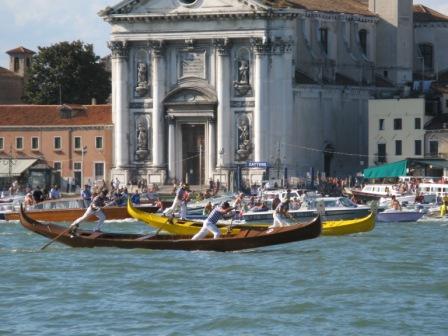
The patriarchal blessing is bestowed on the city from an ecclesiastical station assembled at the entrance to the church of the Redentore. The current patriarch, Angelo Cardinal Scola, seems to like the vantage point. But there are plenty who remember other patriarchs of Venice, who were also cardinals, then popes, then saints, who did it differently.
Both Pope John 23rd (“Papa Roncalli”) 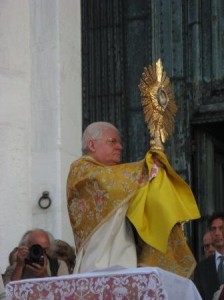 and Pope John Paul 1st (“Papa Luciani”), when this was their humble parish task, took the ciborium containing the consecrated Host and walked to the middle of the votive bridge and intoned the benediction first facing the San Marco side, then turning and facing upstream. One can debate the various merits of each approach if one wishes. One can debate anything, but the old way was more beautiful and more appropriate. I have spoken.
and Pope John Paul 1st (“Papa Luciani”), when this was their humble parish task, took the ciborium containing the consecrated Host and walked to the middle of the votive bridge and intoned the benediction first facing the San Marco side, then turning and facing upstream. One can debate the various merits of each approach if one wishes. One can debate anything, but the old way was more beautiful and more appropriate. I have spoken.